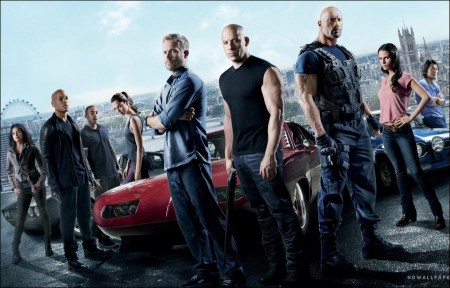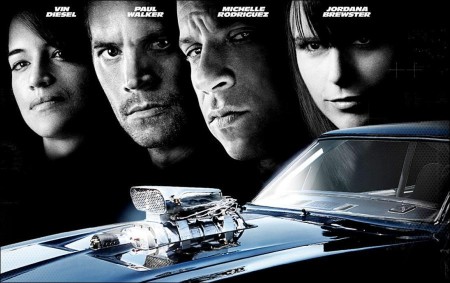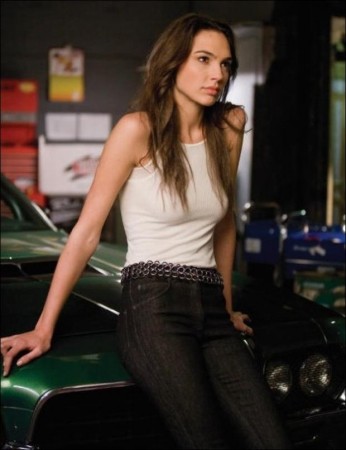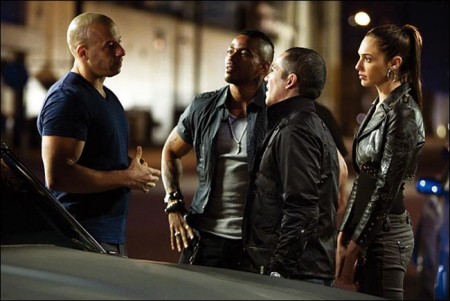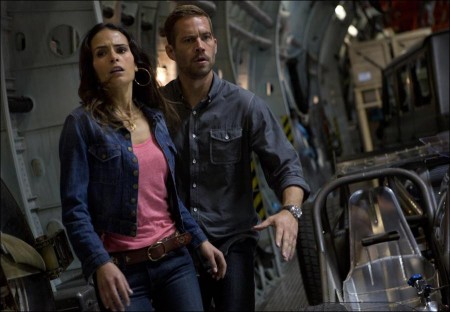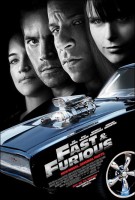All Roads Lead Home
A 1998 Vibe magazine article on street racing clubs set the wheels in motion for what would become one of the most beloved and profitable franchises in Universal Pictures’ history. In 2001, we met champion underground street racer Dominic Toretto and his archnemesis, LAPD police officer Brian O’Conner. Over the course of two hours in The Fast and the Furious, we watched two men on opposite sides of the law race stunning machines, brawl together and form an unlikely, begrudging friendship.
Though they went their separate ways at the end of the film-Dom as an illegal ex-pat to Mexico and Brian to work as an FBI agent in Miami-we followed Brian’s career in the second episode, 2 Fast 2 Furious, and caught a brief glimpse of Dom at the end of the third actioner of the franchise, The Fast and the Furious: Tokyo Drift.
With the subsequent movies, the series continued to build an international fan base and rack up impressive box-office grosses. The lasting visual of Dom thundering across the Mexican border at the end of the original, however, left moviegoers wanting more adventures from our antihero…as well as more stories about the two women in his world-Dom’s girlfriend Letty and his sister Mia (who happens to be the love of Brian’s life).
Eight years after filmgoers first embraced the blistering stunts performed by and passion shared between Dom / Letty and Brian/Mia, producer Neal Moritz wanted to again deliver a film that takes the pulse of pop culture. He knew it was the right moment to bring audiences the fourth installment of the popular series. It was time to come home.
It was not, however, always a given that this chapter would be greenlit. Explains Moritz: “We’ve had a great time and a very successful run with the first three. But if we were really going to go to the next level, we had to bring back Vin and Paul.”
To make that happen would take almost a decade of planning and endless coordination. Says the producer: “We had a lot of conversations over a lot of years. It took schedules meeting up and our coming up with a great story that actually would be worthy of the two of them coming back. We were really lucky to pull it off.”
Reuniting the original foursome of Vin Diesel, Paul Walker, Michelle Rodriguez and Jordana Brewster began, simply enough, with Diesel’s wildly successful cameo in Tokyo Drift, directed by Justin Lin. After seeing a rough cut of the film, Diesel agreed to appear in the final act of the third episode as Han’s (Sung Kang) friend who arrives to challenge Lucas Black”s character, Sean Boswell, to a race.
Over the course of several hours on set, the director and Diesel established an easy rapport. Lin’s attention to minutiae, coupled with his ability to layer characterization amidst powerful action, appealed to the performer who has made a name for himself by developing characters in additional action hits such as xXx and the Pitch Black/Chronicles of Riddick series.
Based on the audience response to Diesel’s cameo, Moritz knew that fans were eager to revisit the Dom-Brian saga. Of the partnership, the producer notes: “The combination of the two of them and seeing how they approach the same scene together is something we can’t invent. That rapport and chemistry either happens on screen or it just doesn’t.”
Echoes producer Fottrell of the connection Diesel and Walker infused in the characters: “A brotherhood still exists between the two. One is brought up on the bad side of the tracks, the other on the good side. Brian is now blending into Dom’s world, and they have each other’s backs. That blood ethic exists between the two of them so that they protect one another, no matter who’s right or who’s wrong.”
Recalls Diesel, who returns as both American muscle car junkie Dom Toretto and as a producer of the film: “I like to do sequels that feel like they are a continuation of the original story. This Fast & Furious script met that criteria.”
He also listened to fan feedback as they reacted to him back in his signature role. Diesel says: “After doing the cameo in the third film, it became clear to me that people were almost saying, `Hey Vin, don’t be too precious on the story…get in there and do the movie. We want to see it.’” The added incentive of reuniting with old friends didn’t hurt. Reveals Diesel: “It’s rewarding to make this movie with people who were a part of my introduction to Hollywood.”
To bring the series full circle, the filmmakers looked to screenwriter Chris Morgan, who previously worked on 2006’s Tokyo Drift and, more recently, 2008’s box-office smash Wanted. Like Moritz and Fottrell, Morgan was keen to reunite the brotherhood. “I’m all about the cars and the culture and the action,” admits the writer, “but what set The Fast and the Furious apart from its limitations was the relationship between these two guys. To be told that you can go back and play with all that is a dream come true.”
What followed was an intense development process in which Morgan was charged with creating the premise that would bring our four heroes together again. As the screenwriter got to work, the filmmakers focused their energy on recruiting Paul Walker, Michelle Rodriguez and Jordana Brewster to commit to a sequel. It was evident that reassembling the cast was an imperative if the producers were to fully realize their story. Diesel, Moritz and Fottrell’s commitment galvanized the others into action.
“I didn’t think I was going make another one,” recalls Walker, of reprising the role of undercover cop / foreign car-aficionado Brian O’Conner for a third time. “And then Neal told me about the master plan. I thought `Why not? I’ll have a good time doing it, and I’ll be hanging out with people I like spending time with.’”
Brian and Dom have different driving styles that mirror their personalities and perspectives on life. Walker felt those distinctions underscored the real-life dynamic between Diesel and him. “It’s a fun contrast,” he says. “It’s East Coast meets West Coast. He’s straight up New York, and I’m as California as it gets. But for some reason, we get along really well. It’s the same thing with Brian and Dom.”
Director Lin also sparked to the idea of bringing back the core characters. In 2001, he was a film student who enjoyed the ride along with the opening night audience. As a filmmaker, this project gave him the opportunity to make a movie that respected the series he had helped to develop, and to introduce the franchise to a new generation.
Of his participation, Lin explains: “It was a no-brainer. Vin and Paul were coming back, and both Michelle and Jordana’s deals were about to close. It’s exciting to have the opportunity to revisit the past, but at the same time explore and build upon a lot of elements with these characters. There was a generation of kids that embraced The Fast and the Furious. It’s exciting to up the ante on something like that.”
His approach to the material dovetailed well with Diesel’s and Walker’s ideas. Because they’d lived with the characters for so long, they both had very specific ideas for the story, cars and action. This shared vision of recapturing and elevating the character-driven action film made Lin the right choice to direct them.
Lin agrees with Moritz and Fottrell about his leads’ on-screen connection: “With Paul and Vin, you get a sense of mutual respect, yet, at the same time, some competitiveness, and that’s always fun on screen. It makes you want to go along for the ride and see where they go.”
The themes of family loyalty and sacrifice have always been integral to the series, and those involved with the films agree these concepts have contributed to their success. Key to framing the storyline was resurrecting the fractured friendship between Dom and Brian, which in turn reverberated to Brian’s broken relationship with Mia.
Dom and Brian, who first developed a kinship over a car’s engine, are bound by a shared code. This sense of family, complicated by his respect for Dom’s freedom, is what Brian has been seeking but has been unable to capture. And though he recognizes the danger of tangling with Dom and facing Mia’s wrath, Brian is willing to head down that road again when Dom returns to L.A.
Last seen crossing the Mexican border, Dom has made his way to the Dominican Republic, where the underground car culture flourishes amidst the tropical heat and pulsing beat of reggaeton (a melding of Jamaican dancehall, reggae and Latin hip-hop). With Letty at his side, Dom has a new life…but one filled with the uncertainty of living as an international fugitive.
The women of Fast & Furious are as strong-willed and skilled as their male counterparts. From her first moment on screen, Michelle Rodriguez has made an indelible impression as the sexy gearhead Letty, a character Diesel refers to as his “first love on film.”
Rodriguez looked forward to developing Dom and Letty’s relationship in the latest chapter. “The stakes are higher,” she offers. “Letty and Dom are on the run, breaking the law wherever they go. There’s a slight Bonnie and Clyde feel to it. The lingering question now is if Dom will risk his love for her in the name of this rush that they’re both addicted to.”
For Jordana Brewster, the chance to revisit familiar terrain with old friends was a welcome one. Agreeing to return with her crew turned out to be even more of a homecoming when she learned Lin would be directing. The actor had worked with the director on the drama Annapolis and looked forward to working with him again.
Despite losing both a brother and her lover, the heartbroken Mia has been able to persevere in L.A. Brewster soon realized that reprising the role wasn’t as easy as she had anticipated. She expected the character Morgan wrote to be riddled with bitterness when faced with the simultaneous return of Dom and Brian. But her director envisioned Mia differently.
“As an actress, you always lean towards the dramatic,” remarks Brewster. “After losing so much, I wanted Mia to hold on to her anger. But Justin intended to keep the women in the film strong and resilient, so Mia has moved on It’s a testament to his ability as a director, because he puts in as much care into these characters as he does with all the action.”
Thugs and Goddesses: Supporting Cast
To complement the returning cast members, the filmmakers and casting directors looked to an array of supporting talent…particularly for the villains who would go head-to-head with the likes of Dom, Brian, Letty and Mia. American Gangster’s John Ortiz and Jarhead’s Laz Alonso were just the actors to fit the bill as, respectively, drug runners Campos and Fenix.
When he began the project, native New Yorker Ortiz was more familiar with the perils of public transportation than with blasting through the underground tunnels of Mexico in the latest-model racers. To get into character, he and Alonso decided early on to create a backstory for their cartel characters. They knew that Campos was the arrogant second-in-command in drug kingpin Braga’s army, while Fenix is the muscle who kills anyone who could complicate his mercenary mission.
To flesh out their pasts, Ortiz relates, “We decided we were best friends who grew up together. He was the guy who took care of me in the school yard. And on the streets, he was the guy who would beat up anyone picking on me. We thought that translated well into what’s going on with us in the film.”
Alonso got into character for the felon that Dom chases when he learns Fenix had a role in killing his friend. The actor saw the sociopath Fenix as a man who thought of Dom as an actual challenge and someone he would “enjoy killing.” Playing the antagonist allowed for a “clash of the titans from the first minute we set eyes on each other,” Alonso states. “My character thinks, `All right, I want to take him out.’”
Also joining the team is stunning newcomer Gal Gadot an Israeli native who makes her feature film debut in Fast & Furious as the treacherous Gisele, a liaison for Dom and Brian to Braga’s empire. Returning for a cameo is Dom’s close friend Han, played by Tokyo Drift’s Sung Kang.
To round out the drug runners who rouse Toretto and O’Conner and set the stage for the homecoming that rocks the L.A. street racing scene, Lin and the casting directors selected a rogues’ gallery of bad guys and badder girls.
Beginning in 2000, Moritz thought to inject another level of street savvy into the series by casting up-and-coming hip-hop artists in each chapter. The filmmakers went to the Caribbean to recruit Latin superstars Don Omar and Tego Calderon, who portray members of Dom and Letty’s Dominican Republic fuel-tanker heist crew.
Tipping a hat to the Latin influence threaded throughout Fast & Furious, the filmmakers tapped into the genre of reggaeton, a style of music that counts Diesel as a fan. It was the actor who first steered Lin and Moritz to Omar and Calderón when the Tokyo Drift soundtrack was being laid out. The two recording artists contributed “Bandaleros,” while Omar also added the single “Conteo.”
Omar, a self-described muscle car fan, is the owner of a 1941 Chevy truck and professes a love of American autos that goes back to working on them with his father when he was a boy. He sums the new cast members’ (and audiences’) feelings about entering the latest chapter of the franchise: “Everybody loves fast cars, beautiful girls and parties. That is the special thing that makes people go crazy and look for another edition of Fast & Furious.”
Completing the core cast is Brian’s team at the FBI, comprising Fun With Dick and Jane’s Jack Conley as his hard-nosed boss, Agent Penning; Pride and Glory’s Shea Whigham as weasel bureaucrat Agent Stasiak; and Cloverfield’s Liza Lapira as Agent Trinh, the brilliant analyst who guides Brian to drug kingpin Campos.
Muscle vs. Import: The Cars of the Film
A car defines the driver, and drivers have their unapologetic preferences when it comes to their rides: import or muscle. The Fast & Furious crew embraces this rivalry and has rolled out close to 250 of the baddest muscle cars and the sexiest tuners to appeal to gearheads who appreciate American heavy metal…or to those who prefer the sublime beauty of a Japanese or European import tuned to perfection.
The filmmakers raised the stakes once again, this time giving Dom and Brian an arsenal of cars to push the limits of speed and endurance. When Morgan put pen to paper, it was a foregone conclusion that the 1970 Dodge Charger that died a spectacular death at the end of The Fast and the Furious would be resurrected for Dom in Fast & Furious. “Not only is the Charger an awesome looking car,” states the writer, “but there’s so much more to it. It tells a story; it represents the soul of Dom.”
Dom maintains his muscle car cred by driving a ’70 Charger and 1970 Chevrolet SS Chevelle, also featured in The Fast and the Furious, as well as a 1987 Buick GNX Grand National and a 1973 F-Bomb Camaro. For his part, Brian mixes it up with a tried-and-true performance import extraordinaire, the 1998 Nissan Skyline GTR, as well as the versatile upstart 2009 Subaru WRX Sti.
It’s a muscle car world with a standout supporting cast of cars that includes Letty’s 1970 Plymouth Road Runner and Fenix’s 1972 Ford Gran Torino, with imports such as Mia’s 2000 Acura NSX and Gisele’s 2007 Porsche Cayman orbiting around it. Not to be outdone, a who’s who of coveted cars appears in the film to satisfy a variety of tastes.
It was up to another series favorite, picture car coordinator Dennis McCarthy, an unapologetic muscle car devotee, to educate the cast and crew on the intricacies of what makes one car more desirable than the next…and to track down vehicles ultimately selected. McCarthy previously worked with Lin and Moritz on Tokyo Drift, a universe that featured primarily Asian imports with a handful of American cars. Once decisions were made about models and makes for this movie, McCarthy had the daunting task of hunting down multiple versions of these often difficult-to-find classic automobiles. The next task was no easier: Build up and customize them so they were up to the rigors of filming.
It was the Dodge Charger that posed the biggest challenge for McCarthy and his team of mechanics. None of the original cars from The Fast and the Furious remained (save on the Universal Studios tour), so a countrywide treasure hunt ensued to literally piece together a total of seven Chargers…as well as some custom rebuilds.
“Dodge Chargers, in any condition, are extremely hard to find,” explains McCarthy, “and we went through roughly seven for filming…so that’s a lot of parts. There just weren’t enough out there.” With the expectation that the Charger had to return, McCarthy’s team came up with a viable solution. “We decided to build a mold of the body out of fiberglass,” he states.“It worked out really well for us.”
One of the car junkie’s luckier breaks came with an offer to build several exact replicas of the bullish F-Bomb Camaro. Built and owned by David Freiburger, a well-known fixture in the car industry, the beauty is a powerful classic coveted by anyone who has seen her move…and delivered the expletive that inspired her curious name.
In addition to the hero cars driven by the core cast, the filmmakers needed to complement the action with a number of unique background cars that audiences have come to demand from each film of the franchise. A McCarthy-found standout that had both cast and crew awestruck was a stunning candy-apple red 1969 Camaro, aptly named “The Big Red.” She is one of the fastest cars in the world and clocks in at 220+ miles per hour.
Once again, the filmmakers hosted the time-honored tradition for custom car owners around the U.S. and Canada: the open casting call. It served as an opportunity for die-hard car buffs to show off their prized customized eye candy; cars, motorcycles, pickups, vans and SUVs were rolled out for the filmmakers to review. The more outrageous, the better, and filmmakers, as always, were not disappointed with the expo.
The level of detail and obsession with the casting-call members’ rides never fails to impress producer Fottrell. He relates: “From the graphics applications to the paint jobs, they really personalize those vehicles. The color schemes, interiors and amount of attention that goes into their work…it blows me away every time I see them.”
The lines are also drawn, albeit unevenly, among cast and crew-who keep the ongoing “muscle vs. import” debate alive with tales of their favorites. Appreciating the nostalgia of American heavy metal, Diesel, Rodriguez, Brewster, Ortiz and Alonso prefer muscle. Walker, however, stays true to his character as a staunch import guy who loves the look and performance of European and Japanese autos.
Since his role in the first chapter of the popular series, Walker has amassed a growing car collection that includes an eclectic mix of both American classics and imports. He even offered several of them for filming…including his 1967 Chevy Nova, which was featured in the Dominican Republic party scene.
Rodriguez is of two minds when it comes to her car preference, but, ultimately, she likes them to be “green.” She says: “In Fast & Furious, I like the muscle cars. The Charger is pretty cool.” She laughingly adds: “I love speed, but I drive a Prius now.” But the actor hasn’t forsaken the occasional adrenaline fix; she’s got her eye on the soon-to-be-released Tesla-a high-performance electric sports car. “It would be really cool if there were a whole league of racecars that were `green.’”
Like Ortiz, Brewster is a New Yorker who didn’t know how to drive when first cast in The Fast and the Furious. In fact, she had to get her driver’s license to work on the first film. This time around, the actor has been living in Los Angeles and has settled into navigating the city’s maze of freeways and side streets. However, eight years hasn’t changed her lack of sentiment for her four-wheeled, juiced-up co-stars. She says a bit sheepishly: “I’m probably a muscle car girl. I still don’t know cars that well; it’s a little embarrassing.”
L.A. to Mexico: Shooting on Location
When returning to the origins of The Fast and the Furious, the filmmakers knew they would be remiss not to revisit the city that helped originate the culture of street racing. Empty warehouses and long-desolate stretches of blacktop barely illuminated by city lights-in the easternmost section of downtown Los Angeles-once again hosted the party for the sexy underground set. The majority of filming during the 85-day shoot was spent on location in L.A. and within its surrounding suburbs. Some stage work was done in the cities of Sylmar and Culver City.
Just as important was the return of some of the previous locations from The Fast and the Furious-specifically, the most recognizable locale from the first installment, the Toretto house and surrounding neighborhood of Echo Park in L.A. The week of night shoots had cast and crew, as well as the growing crowd of onlookers snapping photos, feeling nostalgic and energized. According to producer Moritz, this was only one of “many days on the set when I remembered back to the first film and felt that same camaraderie we had then.”
But returning to these locations eight years later, the filmmakers were faced with a changing landscape. Although the Toretto house was still standing, the new owners had torn down the garage in the rear of the property, which had housed Dom’s beloved Dodge Charger. Not a problem for production designer Ida Random, however. Her team restored it down to the smallest detail.
Los Angeles, Miami and Tokyo served as the backdrop for the first three films, and now Mexico has the spotlight as the setting for Fast & Furious. Latin culture is also woven throughout the film-from the heart-thumping opening sequence in the Dominican Republic (DR) to the thundering chase sequences across the Mexican desert and into smugglers’ tunnels.
It was Diesel’s idea to incorporate the DR as one of the locations for Fast & Furious. References to the Wild West have always been a part of the series, and the raw beauty of the DR served as an ideal hideaway for Dom and Letty as they build a new life together south of the border. To re-create the DR’s diverse regions, Lin’s team lensed in several Southern California locations.
The opening sequence begins with a fuel-tanker heist of a land train rolling along a DR highway, setting the standard for the film’s no-holds-barred action. Letty and Dom lead a team of racers that plots the intricate job. The filmmakers discussed with writer Morgan the fuel problems in that area and how gas was an enormous commodity to regions that could be left without it… often for weeks at a time.
Diesel explains: “What Dom has been so skilled in doing, and has a reputation for in the underworld, is robbing things in motion. He’s a modern-day bandit, very much like the stagecoach bandits. When we see him, he is getting gas for not only himself, but for a whole neighborhood that’s been subject to the exorbitant fuel prices.” The racing tankers Dom and Letty are after were shot on the winding, mountainous roads of the Templin Highway-alongside the Golden State Freeway, north of Los Angeles.
The torch-lit coastline of San Pedro, south of Los Angeles, played home to the post-heist beach party Dom and Letty throw after they successfully score the fuel (and avoid an almost certain death). Naturally, the scene was filled with the requisite sexy, scantily clad beauties partying amongst stunning cars.
Filming the Mexico scenes was two-fold. The majority of photography for the Mexico scenes was conducted on the dusty, tumbleweed landscape of Antelope Valley’s Acton and Canyon County, while the more atmospheric elements of the Mexico locale could not be so easily duplicated. Cast and crew decamped to the small Mexican border town of Magdalena de Kino, located in the country’s Sonora region. A week of filming within the city limits followed.
Rounding out the production team is a band of artists who lent their talents to this latest installment. Some are talented new members, such as cinematographer Amir Mokri, while others are stalwart veterans, such as production designer Ida Random, costume designer Sanja Milkovic Hays, picture car coordinator Dennis McCarthy and 2nd unit director Terry S. Leonard.
Remarks Lin of the people who helped bring this installment to life: “One of the true luxuries of doing bigger budget movies is that you get to work with some of the best craftspeople-the most creative people in the business. To be able to harness all that and maximize everyone’s ability is the most exciting thing about Fast & Furious.”
Filming the Stunts
The producers and Lin knew that action was just as key to satisfying fans as the family reunion of Dom and Letty and Brian and Mia. Eight years have passed, and although the players have changed, the L.A. street-racing game remains the same. Brian spends his days tailing criminals behind the wheel of an FBI-standard issue Crown Victoria, and Dom is a legend whose exploits have been eclipsed by the young guns.
Lin, DP Mokri and 2nd unit director Leonard did their homework when it came to crafting visually credible driving sequences. Staying true to the street-racing subculture, they wanted to infuse the plot with moments that will excite the diehards…as well as raise the bar for the action and, logically, the characters.
“A valuable lesson I learned from Tokyo Drift was how to deliver danger safely on screen,” Lin says. “Nothing beats these cars when they go out on the road-the way they turn, flip and land. We’re all excited to capture it in a new, authentic way.”
For Walker, it was important that the driving in Fast & Furious reflect moves through the streets of L.A. and under the tunnels in Mexico that looked as real as possible. “The first two films were hyper-reality, especially 2 Fast 2 Furious,” says the actor. “I wanted the driving for this one to be as real as possible. I always thought Brian’s driving was different from the other guys. He’s more A to B in a straight shot, as opposed to drifting and style points.”
Adds the director: “It was great talking to Paul about the cars. He’s very knowledgeable about design and the import scene, which has evolved so much, and we wanted to respect that. This time, I’m looking to enhance the actual design of the cars, rather than trying to decorate it.”
From breakneck tunnel drives to hairpin city U-turns, the filmmakers looked to Leonard to execute the audacious driving sequences from Morgan’s script. Alongside stunt coordinator Freddie Hice, Leonard visualized the over-the-top driving sequences and choreographed the hardcore maneuvers that elevate the exploits fans have come to expect with each new film.
Using the tried-and-true camera rigged Porsche Cayenne, the M1 Off-Road Buggy, designed by The Fast and the Furious stunt coordinator Mic Rodgers, they were able to guarantee filmgoers a memorable ride. Referring to a driving shot upon which he improvised, Walker offers: “Justin asked me to come hauling up and then slow down to a stop. It was the second take, so I thought I could do it a little faster. I was pushing it harder and harder and, at one point, I thought I was going to run out of real estate.
“There was a lot of dirt on the road, and the tires were semislick [performs better on clean asphalt] so the grip wasn’t as good,” he continues. “I was doing 80 mph when I finally came to a stop, less than 10 feet from a parked car. It was a bit of a nail-biter, but you couldn’t get it much closer or much hotter.”
To re-create Dom and Letty’s fuel-tanker heist in the Dominican Republic, the scene needed both film units to capture all the movements. Over the course of several weeks, the production used specialized machines with customized features. These included multiple Buick GNXs-all rigged for different stunt techniques (e.g., driving in reverse at high speeds)-as well as self-driving tankers (able to drive solo or haul additional tankers) and rear-drive tankers.
Diesel and Rodriguez were able to experience an adrenaline rush as they filmed the sequence, most notably Rodriguez and her stunt double Heidi Moneymaker, who both, according to Rodriguez, “got to hang off the tanker at 25 miles an hour.” To portray daredevil Letty, they scaled the racing tankers and hung on for dear life.
Diesel sums the cast and crew’s sentiments about getting behind the wheel. He reminisces: “Doing 180s, 360s, 90s…it was a lot of fun to get back behind the wheel. A true car lover will tell you that a car is an extension of his character. So getting back to that reliable, stoic Charger was very fun. It was like an old friend-like an old cast member that I had worked with a long time ago.”
Production notes provided by Universal Pictures.
Fast & Furious
Starring: Vin Diesel, Paul Walker, Michelle Rodriguez, Jordana Brewster, John Ortiz, Laz Alonso, Gal Gadot, Shea Whigham
Directed by: Justin Lin
Screenplay by: Chris Morgan
Release Date: April 3rd, 2009
MPAA Rating: PG-13 for intense sequences of violence and action, some sexual content, language and drug references.
Studio: Universal Pictures
Box Office Totals
Domestic: $154,069,870 (44.6%)
Foreign: $191,583,514 (55.4%)
Total: $345,653,384 (Worldwide)

